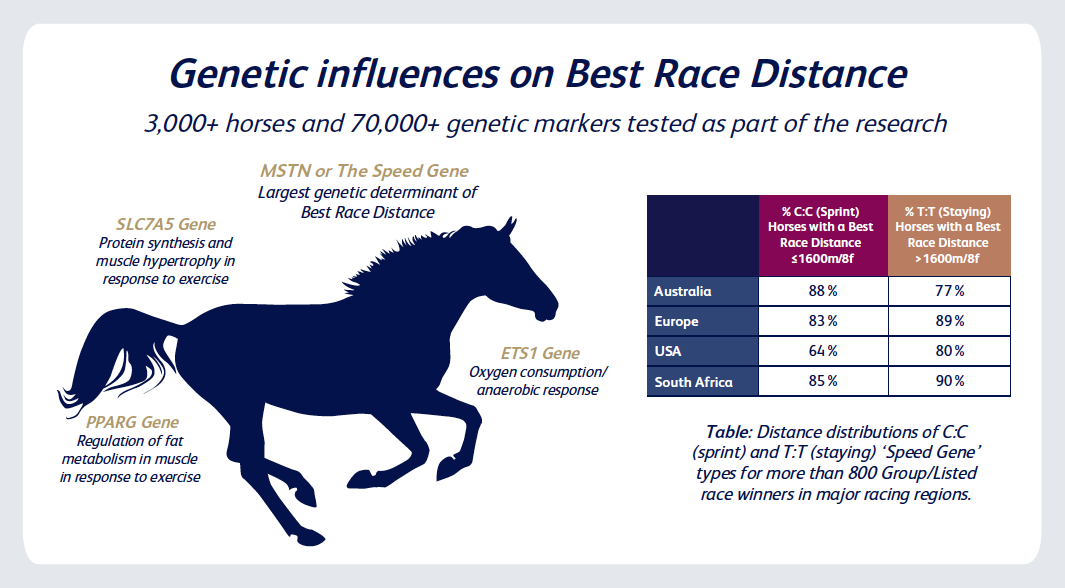Major New Study Provides Unequivocal Evidence The ‘Speed Gene’ Is The Main Determinant Of Race Distance
– Expert says study ends any dispute over the central role of the ‘Speed Gene’
– ‘Stayers’ at serious threat of extinction in global population
[vc_empty_space height=”5px”]A major new study of the race records and genetics of thousands of race horses has provided unequivocal evidence that the
‘Speed Gene’ is the main determinant of why some horses are born sprinters and others are born stayers, or race distance.
The research, published this week in
Equine Veterinary Journal, analysed the genetics and race records of over 3,000 thoroughbred racehorses which raced in Europe, Australia, South Africa and the USA. It found that the
myostatin gene or
‘Speed Gene’ is the almost singular genetic determinant of a horse’s optimum race distance.
The research was led by UCD Associate Professor of Equine Science, Emmeline Hill, who is also Chief Science Officer at leading Irish equine science company
Plusvital.[vc_single_image image=”8492″ img_size=”full” alignment=”center”]
The notion of a single gene being responsible for a performance trait in Thoroughbreds has previously been challenged. However, Professor Hill said the new study ended any dispute over the central role of the
‘Speed Gene’.
“We have replicated and validated our original research findings on a massively larger scale. The power in the numbers has shown that the association of the
‘Speed Gene’ with race distance is as statistically strong as the most highly genetically influenced traits in humans, including eye colour and the probability of an individual going bald” she said.
Optimum Race Distance
The study found that in Europe more than 83% of
‘Speed Gene’ type C:C (sprint) horses had an optimum race distance of a mile or shorter and more than 89% of T:T (staying) horses ran best over distances greater than a mile.
The trend was consistent across all race regions but the race pattern influenced the distribution of the
‘Speed Gene’ types. In Australia, where there is an emphasis on early two-year old speed, there were almost twice as many C:C horses among elite race winners in the population compared to Europe and North America (46% compared to 26% and 28%) and there were almost seven times as many C:Cs as T:Ts within the Australian population.
The main differences between sprinters and staying type horses has been shown to be caused by a mutation in the
‘Speed Gene’ that alters the rate of muscle growth and fibre type differences in the muscle. Although
myostatin is the most important gene, the latest research has also identified
additional genes which have moderate effects on the staying ability of a horse.
Professor Hill said the application of genetics to decision making about how horses were trained and raced is transforming the industry.
“Our results clearly show that using evidence-based science will lead to more accurate placing of horses in races that are best suited to their genetic potential. Horses are a product of their inherited genetic characteristics as well as the environment.”
“The management of the horse is inarguably key in any horse’s success, but DNA differences are the undisputed differences that make them individuals. This genetic information is leading to horses being trained and raced for their genetic potential and is providing a clear economic advantage to owners and trainers” she said.
‘Stayers facing serious threat of extinction’
Considering the major influence of the gene, the research has relevance for the wider Thoroughbred population.
“Since there is just one gene that is a major player in the sprinting versus staying stakes, it is extremely vulnerable to selection pressures. This has been recognised by the concern in the industry over the potential reduction in genetic diversity by favouring precocious, commercially attractive horses. This concern is well justified, the staying type is at serious threat of extinction in the global population. T:T (staying) types make up less than 17% of elite race winners in Britain and Ireland and less than 7% of the Australian elite winning population. This is a complete reversal from the picture of genetics of the Thoroughbred 150 years ago.”
“We do not operate our
testing services in the sales environment which could further accelerate this trend. However, it is essential that the industry incentivises the breeding and racing of stayers to reduce the pressure to breed for the sales ring” concluded Professor Hill.
[vc_video link=”https://youtu.be/6i5k_K0GqRA” align=”center”]
Read the full published paper on this new study
here.
Learn more about Plusvital’s full range of cutting-edge genetic tests
here.
